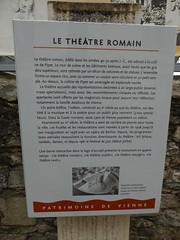Théâtre Romain de Vienne
Commemorated on 1 plaque
Le Théâtre Romain Le théâtre romain, édifié dans les années 40-50 après J.-C., est adossé à la colline de Pipet. Le mur de scène et les bâtiments latéreaux, aussi hauts que les gradins supérieurs, sont rythmés par un décor de colonnes et de statues. L'ensemble forme un espace clos, avec au sommet un couloir semi-circulaire et un petit temple. Au-dessus, la colline de Pipet est aménagée en esplanade sacrée. Le théâtre accueille de représentations destinées à un large public (environ 11000 spectateurs), mais aussi des rassemblements civiques ou officiels. Les spectacles sont offerts par les magistrats locaux pour assurer leur réélection, notamment la famille Astiaticus de Vienne. Un autre édifice l'odéon, construit au IIe siècle au sud du théâtre, est destiné à la musique et à la poésie pour un public plus restreint (2000 spectateurs). Dans le Gaule romaine, seuls Lyon et Vienne possédent un odéon. Abandonné au IVe siècle, le théâtre a servi de carrière de pierres pour toute la ville. Les fouilles et les restaurations sonts menées à partir de 1908 jusqu'à son inauguration en 1938 avec un opéra de Berlioz. Depuis, les programmations estivales ressuscient la fonction divertissant du théâtre : art lyrique, variétés, danses, et depuis 1981 le festival de jazz (début juillet). Une borne interactive dans la log d'accueil présente le monument en quatre temps : «le théâtre romain», «le théâtre oublié», «le théâtre resurgit», «le théâtre revit»
English translation: The Roman Theatre The Roman theatre, built in the years 40-50 AD, is leaned against the hill of Pipet. The stage wall and lateral buildings, as tall as the upper tiers, are punctuated by a decor of columns and statues. The whole forms an enclosed space, with at the top a semicircular corridor and a small temple. Above, the hill of Pipet is arranged as a sacred esplanade. The theatre hosts performances for a large audience (about 11,000 spectators), as well as civic or official gatherings. The shows are offered by local magistrates to ensure their re-election, especially the Astiaticus family in Vienna. Another building, the Odeon, built in the 2nd century to the south of the theatre, is destined for music and poetry for a more limited audience (2000 spectators). In Roman Gaul, only Lyon and Vienna have an odeon. Abandoned in the 4th century, the theatre served as a stone quarry for the whole city. Excavations and restorations were carried out from 1908 until its inauguration in 1938 with an opera by Berlioz. Since then, the summer programs have resurrected the entertaining function of the theatre: lyrical art, variety, dance, and since 1981 the jazz festival (early July). An interactive kiosk in the welcome log presents the monument in four stages: "the Roman theatre", "the forgotten theatre", "the theatre re-emerges", "the theatre revives"
Rue du Cirque, Vienne, France where it built

